Brilliant fireball lights up night sky after SpaceX Crew-3 astronaut launch
Stargazers watching the rocket launch got an extra light show.
A bright fireball streaked across the sky over the eastern U.S. yesterday (Nov. 10), shortly after the liftoff of SpaceX's Crew-3 mission to the International Space Station.
The American Meteor Society (AMS) has reported nearly 400 sightings of the fireball to date, with some witnesses being able to observe simultaneously the fireball and the SpaceX Falcon 9 rocket trail. Most observations came from North Carolina, but some reports also arrived from Washington, D.C., Delaware, Georgia, Maryland, New Jersey, Pennsylvania, South Carolina, Tennessee, Virginia and West Virginia, the AMS said in a statement.
The fireball brightened up the sky at 9:12 p.m. EST (0212 GMT on Nov. 11), nine minutes after the Crew-3 liftoff. According to the AMS, the meteor was part of the Taurid meteor shower, which occurs every year between September and November when Earth passes through a broad stream of debris in the wake of Comet Encke.
Related: Taurid meteor shower: Winter fireballs

The meteor was visible for only about 3.5 seconds. Data from a NASA fireball camera in western North Carolina suggest that the rock had a mass of about 45 pounds (20 kilograms) and was about 10 inches (25 centimeters) wide. It broke apart at the altitude of 28 miles (45 kilometers), as it passed above Macclesfield, a tiny village in North Carolina, travelling in the northwestern direction at about 33,000 mph (53,000 kph), AMS said in the statement.
Massive fireball meteor under the SpaceX #Crew3 launch this evening from Central Virginia. Unbelievable moment as the rocket flew over. 80" total exposure time. Falcon 9 2nd stage flyby is the long streak.📍 Gordonsville, VA pic.twitter.com/V0tPqqGX7lNovember 11, 2021
Every day, several thousand meteors burn up in Earth's atmosphere, AMS said. Most of them, however, go undetected as they come in above the oceans or during daylight hours.
The brighter the fireballs, the rarer they are. AMS said that a fireball of visual magnitude -6 could be detected every 200 hours of observation, while a -4 magnitude fireball can be expected about once every 20 hours or so.
Get the Space.com Newsletter
Breaking space news, the latest updates on rocket launches, skywatching events and more!
The lower the magnitude number, the brighter the object. For example, the sun has a magnitude of -27.
Follow Tereza Pultarova on Twitter @TerezaPultarova. Follow us on Twitter @Spacedotcom and on Facebook.
Join our Space Forums to keep talking space on the latest missions, night sky and more! And if you have a news tip, correction or comment, let us know at: community@space.com.

Tereza is a London-based science and technology journalist, aspiring fiction writer and amateur gymnast. Originally from Prague, the Czech Republic, she spent the first seven years of her career working as a reporter, script-writer and presenter for various TV programmes of the Czech Public Service Television. She later took a career break to pursue further education and added a Master's in Science from the International Space University, France, to her Bachelor's in Journalism and Master's in Cultural Anthropology from Prague's Charles University. She worked as a reporter at the Engineering and Technology magazine, freelanced for a range of publications including Live Science, Space.com, Professional Engineering, Via Satellite and Space News and served as a maternity cover science editor at the European Space Agency.
